
Strawberry Roll Cake
| Ingredient | Two 9-inch Rolls | Two 22cm Rolls |
|---|---|---|
| Cake | ||
| cake flour | 1 cup (4 oz.) | 110g |
| corn starch | scant 4 Tbsp. (1 oz.) | 30g |
| egg | 8 | 8 |
| sugar | ¾ cup + 2 Tbsp (3⅓ oz.) | 180g |
| Syrup | ||
| sugar | 2 Tbsp. | 2 Tbsp. |
| water | 3 Tbsp. | 3 Tbsp. |
| rum | 1 Tbsp. | 1 Tbsp. |
| Filling | ||
| heavy cream | 1⅔ cups | 400ml |
| sugar | 4 Tbsp. | 4 Tbsp. |
| fresh strawberries | 10 oz. | 300g |
Closer to a strawberry shortcake than the familiar American jelly roll, this curl of tender cake, strawberries, and cream looks as good as it tastes. Roll cakes like this are a perennial favorite in Japan, although you can of course find similar cakes around the world.
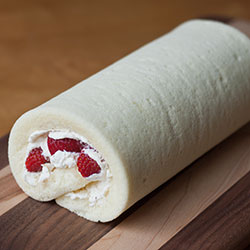
Preparation
- Sift flour and corn starch together.
- Let eggs come to room temperature.
- Make the syrup: Mix water and sugar and heat in microwave until sugar blends completely; let cool and stir in rum. Set aside.
- Wash strawberries, remove stems, and pat dry. Cut the tips off to make them somewhat rounder (save the small pieces, as well), and if they’re very large strawberries also cut them in half. Cover and put them in the refrigerator.
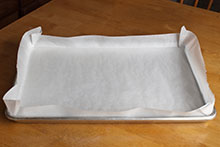 Cut a piece of parchment paper to cover the bottom and sides of a 13 by 18 inch (33 by 46 cm) baking sheet pan (standard half-sheet pan).
Cut a piece of parchment paper to cover the bottom and sides of a 13 by 18 inch (33 by 46 cm) baking sheet pan (standard half-sheet pan).
Directions
- Whip eggs in a warm water bath until frothy.
Crack the eggs into a large bowl and beat together lightly. Place the bowl into a larger pan of water that is somewhat hot to the touch (60-70°C/150°F) and beat with an electric mixer on low until the eggs become a little frothy. - Beat sugar into eggs.
Still in the warm water bath, continue beating on low while adding the sugar in two or three portions, allowing sugar to mix well before adding more. - Remove from bath and whip.
When the mixture has warmed to about body temperature, remove the bowl from the water bath. Whip the egg mixture at high speed for about 5 minutes. Reduce speed to medium and continue beating for another 5 minutes. The mixer should leave a ribbon-like trail at this point. Reduce speed to low, and beat for another 5 minutes to break up larger bubbles and smooth the texture; the mixture should look shiny and fall in a ribbon when you lift the mixer. Keep in mind that these times are just for reference; the texture is what’s important. - Sift the flour into the egg mixture and fold together.
Sift one quarter of the flour and corn starch mixture into the bowl; try to keep some distance between the bowl and the sifter. Fold gently into the batter until mixed, being careful not to deflate the foam. Repeat three more times until all flour mixture is added and the batter is mixed. - Stir throughly.
At this point the flour should be completely mixed in, but the batter won’t be totally smooth. Using the spatula and a scrape-and-fold motion while rotating the bowl, continue gently mixing until the batter is smooth and a bit runnier, about five minutes. This additional mixing breaks more of the bubbles created by the mixer. - Pour and bake.
Pour the batter into the prepared sheet pan, scraping the last of the batter in the bowl into the outside edge of the pan where it will cook the most quickly. Flatten the top surface with the spatula. Lift the pan and gently tap the bottom on the work surface a few times to even it and bring any bubbles to the top. Bake at 350°F (180°C) for 20-22 minutes, until a cake tester inserted in the middle comes out clean. - Drop the pan on a flat surface, then cool.
 Immediately after removing from the oven, hold the pan about 8" (20cm) above a table, and drop it so it lands flat; this will prevent the cake from falling. Balance the pan on as large a cake rack as you have, and let sit until completely cooled.
Immediately after removing from the oven, hold the pan about 8" (20cm) above a table, and drop it so it lands flat; this will prevent the cake from falling. Balance the pan on as large a cake rack as you have, and let sit until completely cooled. - Divide cake and remove paper.
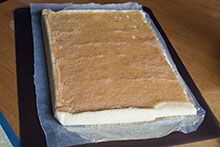 Remove cake from pan, leaving the parchment paper on the cake. Cut it in half in the middle of the long side, giving you two 9" (22 cm) sheet cakes. Peel the parchment paper off each carefully, then lay the cakes back on top of the parchment paper, with the same side of the paper that was just removed in contact with the cake.
Remove cake from pan, leaving the parchment paper on the cake. Cut it in half in the middle of the long side, giving you two 9" (22 cm) sheet cakes. Peel the parchment paper off each carefully, then lay the cakes back on top of the parchment paper, with the same side of the paper that was just removed in contact with the cake. - Put syrup on cake.
Using a brush, dab half of the syrup onto the top surface of each cake. - Prepare whipping cream and spread first layer.
Combine sugar and chilled whipping cream in a bowl and whip until relatively stiff. Orient the cakes with the short edge toward you and spread a layer of whipping cream on each cake, making the cream at the far end a little thinner than the front. Make sure to save some cream. - Arrange strawberries.
Put a row of large strawberries across each cake, a little closer to you than halfway up. Add a row of the small tips you cut off right above the row of large strawberries, and another row of the tips halfway between the row of large strawberries and the edge closest to you. Cover the row of large strawberries with the remainder of the whipping cream.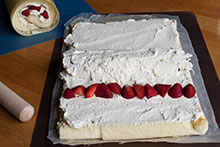

- Roll cakes.
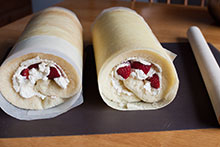 To roll each cake, starting with the edge of the cake closest to you, fold it up relatively sharply part way over the row of small strawberry pieces to form the core of the cake. Then, place a rolling pin or other similar rod underneath the parchment paper and lift up the core you just made. Use the rod and paper to fold the cake over the row of large strawberries. Roll the cake a little farther to complete the cylinder, then tighten the paper to firm it up. Wrap the paper firmly around the cake (leave the ends open) and make sure it’s solid, then refrigerate, wrapped, with the seam of the cake on the bottom, for at least an hour. For longer-term storage, also cover in plastic wrap, to prevent it from drying out.
To roll each cake, starting with the edge of the cake closest to you, fold it up relatively sharply part way over the row of small strawberry pieces to form the core of the cake. Then, place a rolling pin or other similar rod underneath the parchment paper and lift up the core you just made. Use the rod and paper to fold the cake over the row of large strawberries. Roll the cake a little farther to complete the cylinder, then tighten the paper to firm it up. Wrap the paper firmly around the cake (leave the ends open) and make sure it’s solid, then refrigerate, wrapped, with the seam of the cake on the bottom, for at least an hour. For longer-term storage, also cover in plastic wrap, to prevent it from drying out.
Notes
- Getting the sponge to turn out correctly requires fairly precise measuring of ingredients, which is difficult measuring by volume; I highly recommend using a kitchen scale and weighing your ingredients if at all possible.
- If you have problems with the cake cracking when you roll it, you can score it prior to rolling with a knife. To do this, lightly press lines along the length of the roll (widthwise, if you're going to roll the cake away from you, that is) with a knife blade, starting at the beginning of the roll; put three lines separated by about ¾" (2cm), then a line every 1½" (4cm) along the rest of the cake.
- When rolling the cake you of course don’t need to use a rolling pin, but it’s easier if you have one.
- An alternate way to distribute the strawberries is to just sprinkle them across the surface of the whipping cream; cut them into smaller pieces in this case.
